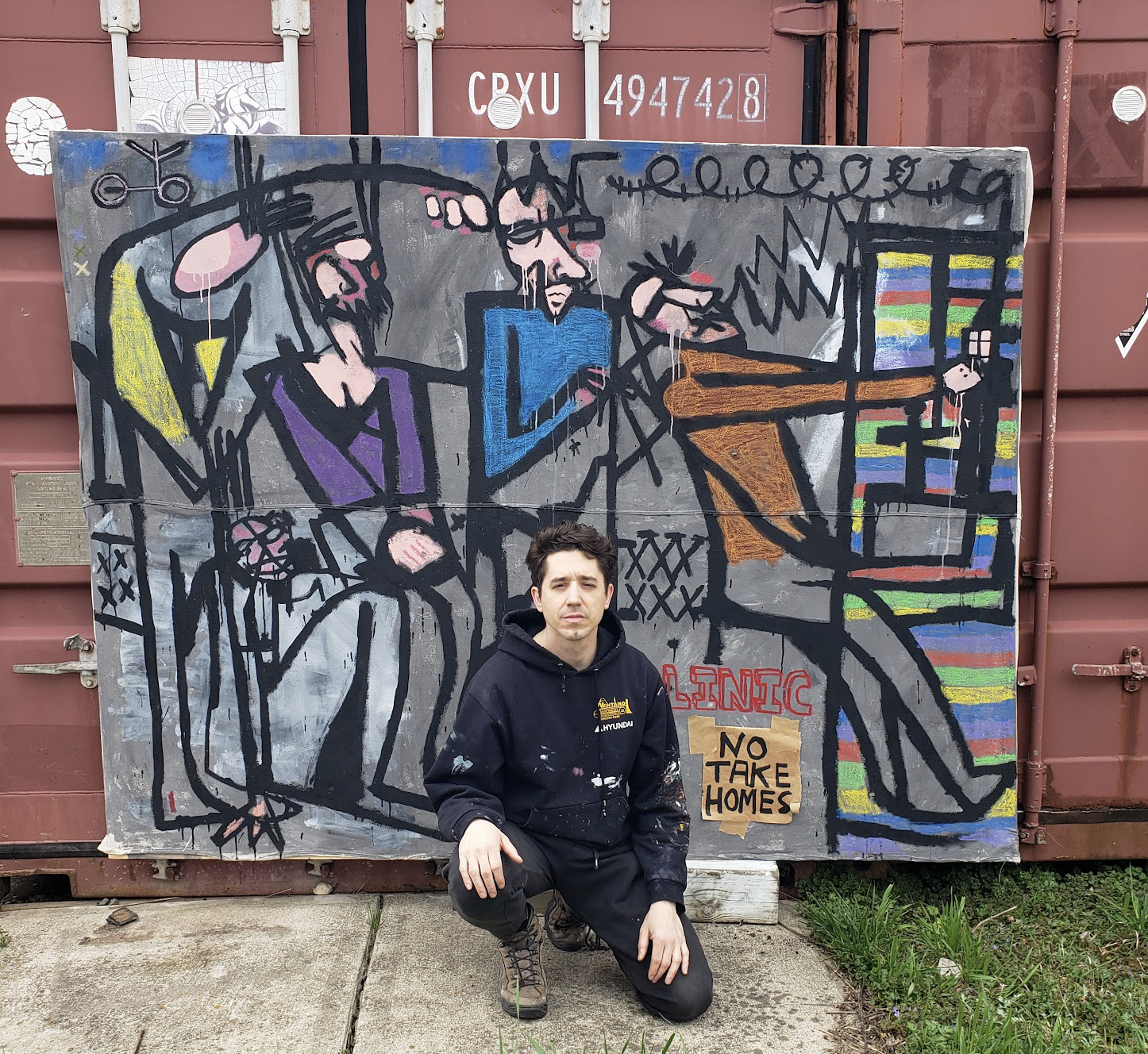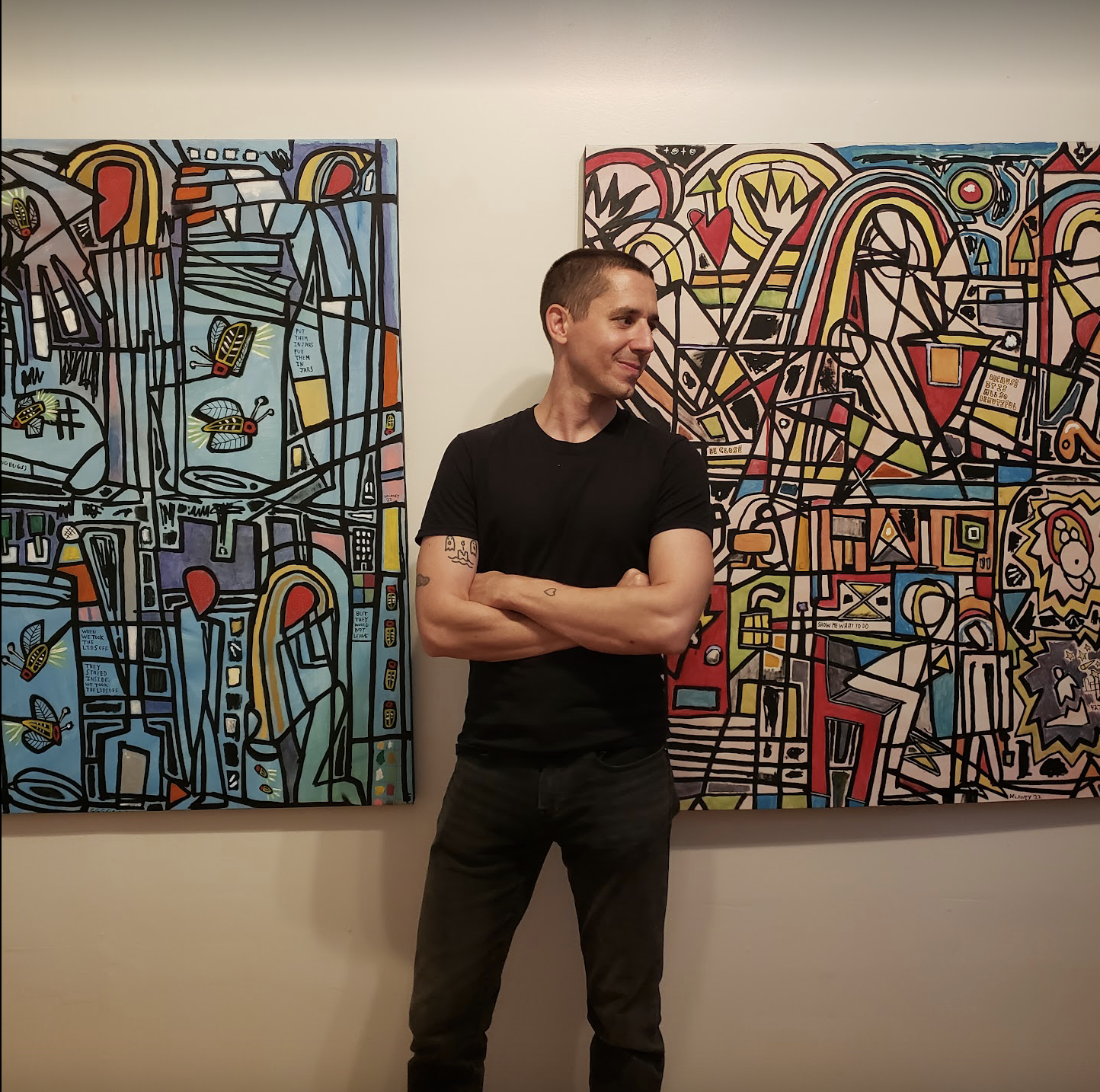Michael Delaney
Michael Delaney is a self-taught artist working in New York. He works in an evocative and graphic style that is reminiscent of city graffiti work. Using oil paint on wood panels, Michael creates eclectic and absorbing work that captures the dialogue between moments and impressions. His compositions are personal to him but symbolize collective experiences as well. In this interview, Michael speaks to his work and process.
How did your creative journey begin?
My creative journey started when I was a kid. I would draw pictures and write songs. I’ve always had a difficult time communicating with people. I liked writing songs because it helped me communicate how I felt. When I moved on to painting, I was very discouraged. Painting is very intimidating at first and the materials were very expensive and confusing. I discovered the joy of painting when I switched to using house paint and recycled materials like cardboard boxes and wood that I found on the street. This gave me lot of freedom to experiment. I found that paintings could do mostly everything that a good song could do: communicate emotions and tell a story. This really sold me on painting. I can be very powerful technology.
What inspires your work?
I am inspired by memories, personal relationships, and the natural world. I also spend a lot of time thinking about the existence of supernatural things, science and spirituality – so I do a lot of paintings about this stuff. Sometimes, I find inspiration in very dumb things. I’ll do ten paintings of my toilet bowl and my girlfriend will come over and look at me like I’m out of my mind. I hit a lot of dead ends.
Can you describe your process?
I like to paint in one-hour spurts. Painting longer then one hour will end up looking bad. So I break things up into in one-hour chunks. I’ll map out my large acrylic paintings with these several steps: planning, underpainting, outlining, blocking in color, adding text, adding highlights, then top coating. Each step may have multiple sessions but no session will last longer than 1 hour.
My oil paintings are usually done wet-on-wet in a single session. Then I’ll do some final details in charcoal and varnish it. Painting with oil is just so much fun. I could oil paint 24/7.
My painting sessions can be very ritualistic. I get into a strange state and it’s hard to come out of it. I used to do a lot of painting on the street, plein air painting, but it got to be too dangerous because I’d wander out into oncoming traffic or trip over curbs.
How has your work evolved over time?
The biggest way my work has evolved is that I now stick to consistent sizes – either (48X48 or 12X12) and I use lightweight materials (either unstretched canvas, painted cardboard or paper). I will always make more paintings then I can sell, so using consistent sizes and lightweight materials has helped with storage and enables me to paint more.
Especially, I’ve had to learn to stop experimenting so much. I get so caught up in experimenting with materials and processes that I don’t focus on refining what I can actually do well. When I first got my studio, I was trying all kinds of art processes like printing, sculpture and epoxy work. They all looked very bad. I’ve learned to focus on refining processes that actually work for me.
What does a typical creative day look like for you?
I start my day with a few quiet minutes of meditation, contemplation and sketching, Then I’ll paint for an hour before my dayjob starts. I try to paint for an hour at night too. Life is very busy but if I don’t paint for two or three days at a time then I’ll start feeling agitated and unfulfilled. I usually have a few large acrylic paintings in progress. Or I’ll work on a little oil painting for fun. There is always stuff to work on.
Do you have any words of wisdom for other artists and creatives?
The best advice I ever got came from a guy who worked at an old art store in NY. He told me buy my art materials from the hardware store. Use inexpensive materials! If you really need fine art materials, you can find them on ebay or craigslist. Don’t let the big art stores intimidate you – most of the stuff there is useless.
Finally – make art that stirs YOU. If you make art to try and impress other people, then it will be obvious and people will intuitively reject it. It’s a weird paradox that I’ve found. Also, if you’re not happy when you’re painting it, then people will pick up on that subconsciously. They will reject it. The answer to all of this is to have fun while creating. That’s the joy.














